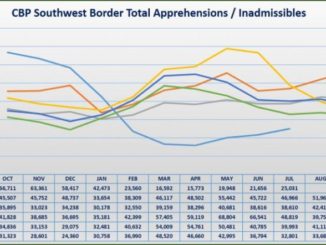
by David Brier
Jose Ines Garcia Zarate, the immigrant who entered the United States illegally and was charged with murdering California resident Kate Steinle in 2015, was found not guilty Thursday by a San Francisco jury. President Trump, who has used Steinle’s death to promote harsh immigration policies, quickly responded by calling for a border wall, adding that the “Steinle killer came back and back over the weakly protected Obama border, always committing crimes and being violent.”
These claims are just not true. In reality, the case highlights how much border security has improved and how little a threat undocumented immigrants pose. From 1991 to 1996, Garcia Zarate did cross the border illegally a couple of times. But as Border Patrol doubled and then tripled the number of agents, it caught him every time — twice in 1998, in 2003 and again in 2009, the only attempt in the Obama era.
Even when Garcia Zarate did make it over the border in the early 1990s, he never committed violent crimes, but rather activities such as “inhaling vapors,” selling “imitation drugs” and possessing marijuana and heroin. After each border apprehension since 1998, he served years-long prison terms for attempting to reenter illegally after his deportations. He certainly broke laws, but never with violence.
Rather than as a result of weak border protections, Garcia Zarate ended up in San Francisco through multilevel bureaucratic incompetence. San Francisco’s sheriff’s office requested that the federal Bureau of Prisons transfer him at the end of his sentence in 2015 to face a marijuana possession charge, even though the city had since deprioritized prosecutions of marijuana possession.
BOP complied with this request, inexplicably ignoring federal Immigration and Customs Enforcement, which had asked that the BOP turn him over for deportation. ICE then requested that San Francisco detain him and notify agents when he was released. Yet ICE knew that the city had a policy of honoring only federal warrants issued by judges, not requests from ICE agents.
City officials had met with ICE to inform the agency of its policy beforehand, yet the agency simply chose not to seek a warrant. This meant that once the San Francisco district attorney declined to prosecute the marijuana charge, the city’s law required Garcia Zarate’s release.
Yet even then, the sheriff’s office continued to hold him for nearly three weeks, asking the federal government whether it had any warrants for his arrest. Only after hearing a no was he released. ICE had plenty of time to go to a judge to seek a warrant and present probable cause that Garcia Zarate was in the country illegally. It chose not to do that.
After Steinle’s death, BOP changed its policies to give ICE the opportunity to take custody of any prisoners before it turns them over to states or localities. ICE, however, still stubbornly refuses to seek warrants in jurisdictions that require one. ICE prioritizes administrative convenience over effectiveness.
Trump has previously blasted San Francisco’s policy of requiring a warrant, calling it a “sanctuary” policy. But San Francisco only adopted its policy after ICE repeatedly issued requests to detain people who turned out to be U.S. citizens and courts found localities liable for damages if they honored the requests. Such cases have emerged repeatedly since the Steinle incident.
Requiring probable cause and judicial review are not “sanctuary” policies, except for the innocent. Now, the U.S. Marshals Service has issued a warrant for Garcia Zarate, which San Francisco will honor. Nonetheless, ICE’s policy should change — not just because it allowed Garcia Zarate to go free but because it fails to provide adequate protection for U.S. citizens.
Ultimately, the jury found that Steinle’s death was probably an accident — from a single shot that ricocheted about 90 feet off the pavement fired from a gun with a history of accidental discharges set off by a drug addict who a judge had ordered be put in a mental-health facility. This accident cannot justify a nationwide crackdown on unauthorized immigrants who are, based on census data, half as likely as U.S.-born citizens to commit the types of serious crimes that lead to incarceration.
Rather than mass deportations, the federal government should adopt smart, targeted policies to target serious criminals and prevent bureaucratic mistakes. This case is a tragedy with horrible consequences. But hard cases make bad law. Congress should focus on the big picture: Immigrants — documented and undocumented — commit fewer such crimes, and ultimately more peaceful people make neighborhoods safer.
David Bier is an immigration policy analyst at the Cato Institute.



